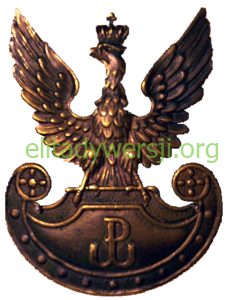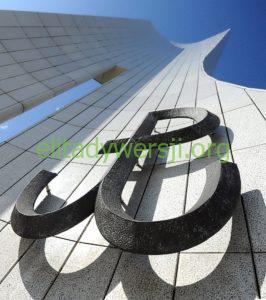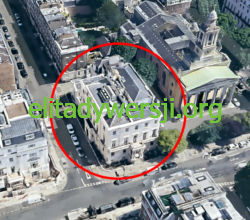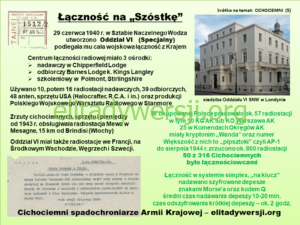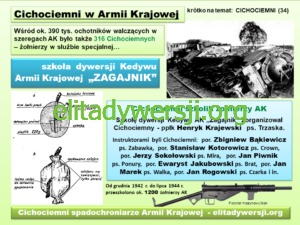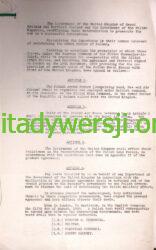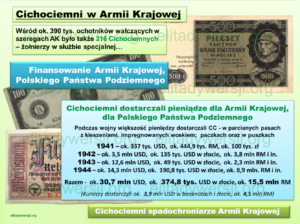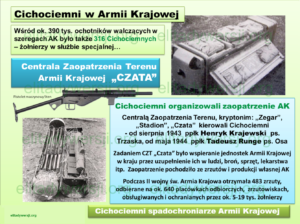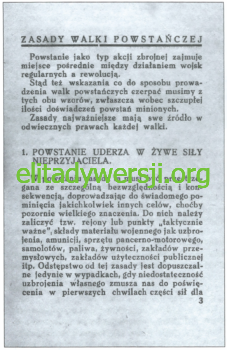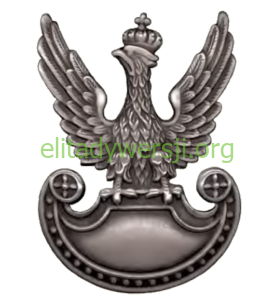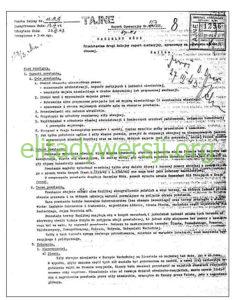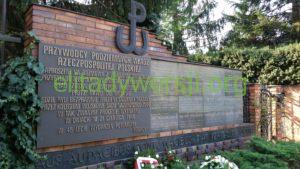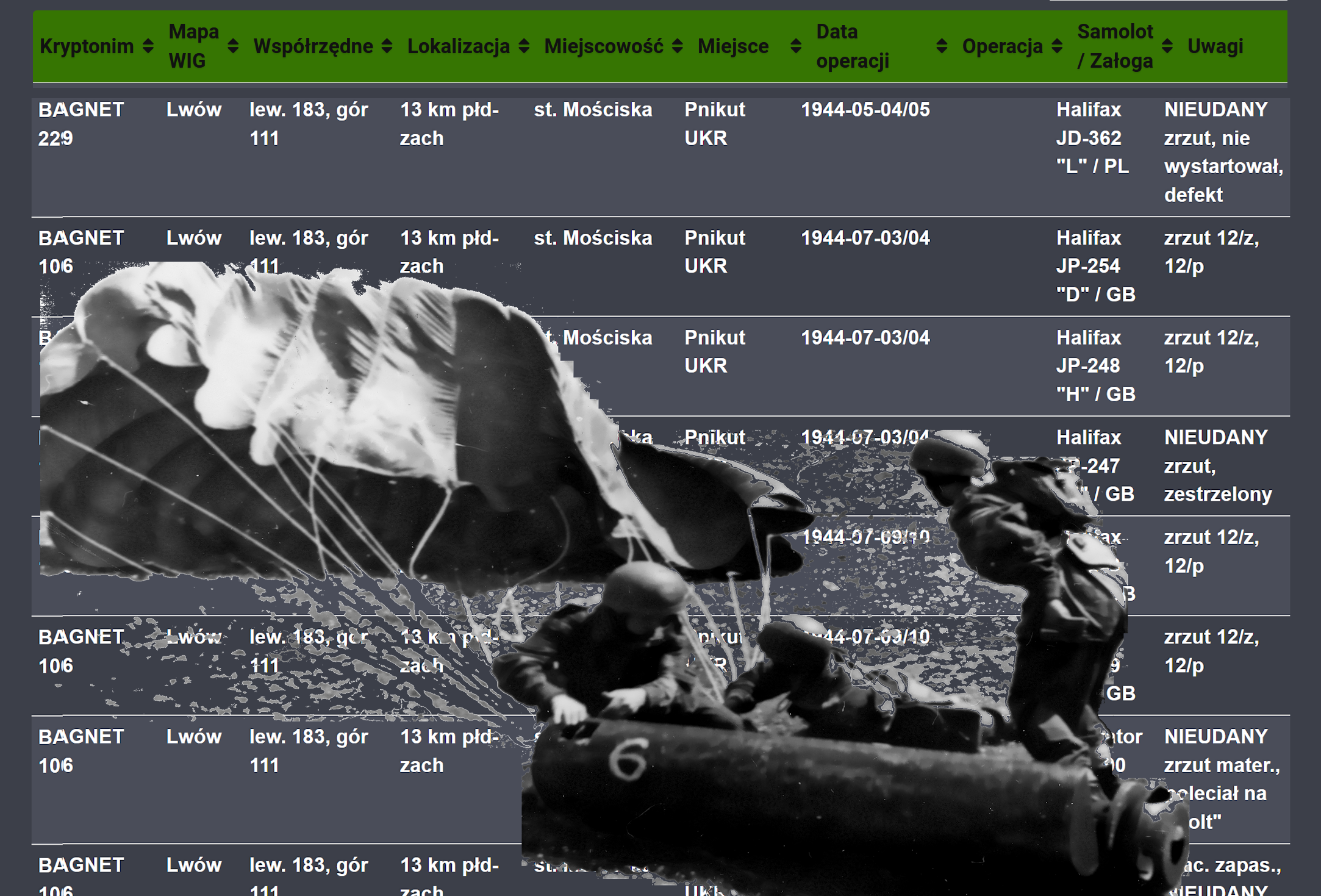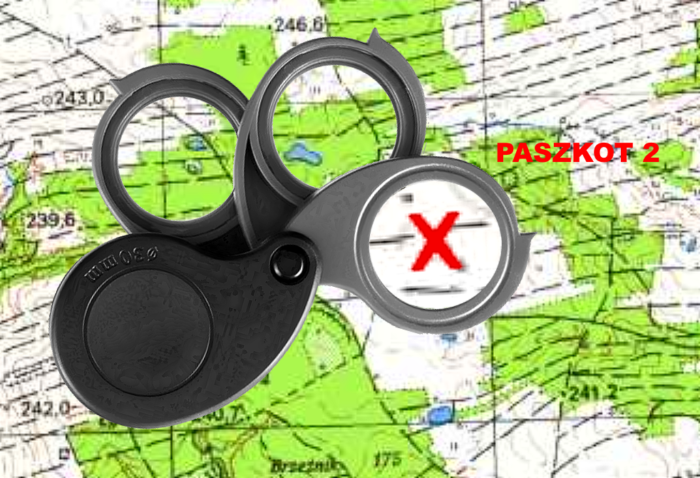Armia Krajowa
- Wstęp
- Fenomen Polskiego Państwa Podziemnego
- Konspiracyjna Armia Krajowa
- Dywersja i wywiad
- Formacje dywersyjne
- Cichociemni
- Status prawny Armii Krajowej
- Finanse Armii Krajowej
- Przygotowanie powstania powszechnego w Polsce
- Akcja Burza
- Powstanie Warszawskie
- Proces szesnastu
Zobacz najnowszą wersję bazy danych nt. zrzutów:
BAZA ZRZUTÓW DLA ARMII KRAJOWEJ
Armia Krajowa – zakonspirowane siły zbrojne Polskiego Państwa Podziemnego, działające na terytorium II Rzeczypospolitej, okupowanym przez hitlerowskie Niemcy oraz ZSRR. Armia Krajowa była wojskową strukturą Polskiego Państwa Podziemnego, jej elitą byli Cichociemni.
Jej protoplastą były: Służba Zwycięstwu Polski utworzona 27 września 1939 oraz Związek Walki Zbrojnej powołany 13 listopada 1939 przez władze R.P. 14 lutego 1942 rozkazem Naczelnego Wodza – generała broni Władysława Sikorskiego – została przemianowana na Armię Krajową.
Była najliczniejszą, najdłużej działającą, a także stosującą najbardziej zróżnicowane formy walki najsprawniejszą, najlepiej zorganizowaną formacją zbrojną w okupowanej Europie. Była podziemnym Wojskiem Polskim. Niezwykłe jest także to, że Jej prymatem była walka o niepodległość Polski ponad partyjnymi i politycznymi uprzedzeniami.
W skład Armii Krajowej weszły m.in. oddziały: części Narodowej Organizacji Wojskowej (od 1942), Konfederacji Narodu (od sierpnia 1943), części Narodowych Sił Zbrojnych (od 1944), części Batalionów Chłopskich (od 1943), Gwardii Ludowej WRN (od 1940).
Zanim kraj upadł, polskie władze położyły fundament pod rozległą organizację zbrojnego oporu. W kraju pozostało dziewięciuset Polaków wyszkolonych w walce partyzanckiej, a w trzystu podziemnych schronach w całym kraju zmagazynowano materiały wybuchowe, granaty, karabiny i pistolety. Polska spośród wszystkich okupowanych krajów najbardziej odrzuciła kolaborację. Jej Armia Krajowa (od 14 lutego 1942 roku, wcześniej od listopada 1939 – Związek Walki Zbrojnej) – największy, najbardziej zaawansowany i najlepiej zorganizowany ruch oporu w całej Europie – nie pozostawiła żadnej wątpliwości, że oczekuje od Polaków, że przeciwstawią się Niemcom w każdy możliwy sposób – poczynając od odmawiania współpracy, a kończąc na dywersji i sabotażu
Lyne Olson, Wyspa ostatniej nadziei. Anglicy, Polacy i inni, s. 188
Fenomen Polskiego Państwa Podziemnego
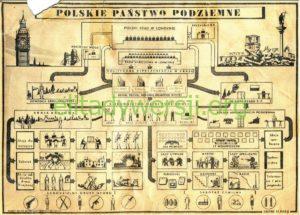 Polskie Państwo Podziemne – funkcjonujące podczas II wojny św. w okupowanej Polsce konspiracyjne struktury polskiego państwa, podległe rządowi na uchodźstwie (najpierw we Francji, potem w Wielkiej Brytanii) były fenomenem na skalę światową. Nie było nigdy nigdzie na świecie tak rozbudowanej oraz tak sprawnie funkcjonującej struktury.
Polskie Państwo Podziemne – funkcjonujące podczas II wojny św. w okupowanej Polsce konspiracyjne struktury polskiego państwa, podległe rządowi na uchodźstwie (najpierw we Francji, potem w Wielkiej Brytanii) były fenomenem na skalę światową. Nie było nigdy nigdzie na świecie tak rozbudowanej oraz tak sprawnie funkcjonującej struktury.
Podczas wojny Polska miała na emigracji rząd w Londynie oraz Polskie Siły Zbrojne na Zachodzie. W okupowanym kraju funkcjonowała wojskowa struktura PPP – Armia Krajowa, także podziemne sądy, wydające wyroki, które egzekwowali żołnierze AK. Cywilną strukturą Polskiego Państwa Podziemnego była Delegatura Rządu na Kraj.
Przez całą okupację działały tajne komplety, czyli podziemne szkoły. Na terenie Generalnej Guberni działało ok 2 tys. szkół średnich. Podziemne uczelnie podczas wojny wyszkoliły w konspiracji ok. 10 tys. studentów. Przez cały czas okupacji wydawano podziemną prasę (ok. 1400 tytułów) oraz książki. Na przełomie 1943/44 łączny nakład prasy podziemnej wynosił ok. 250 tys. czasopism, 65,5 tys. broszur oraz ok. 120 tys. ulotek. Działały także podziemne teatry, organizowano koncerty, wieczory poetyckie. Pieniądze na funkcjonowanie struktur wojskowych oraz cywilnych Polskiego Państwa Podziemnego dostarczali głównie (89 proc.) Cichociemni; w części dotyczącej struktur cywilnych także kurierzy polityczni…
Marek Ney-Krwawicz – Fenomen Polskiego Państwa Podziemnego
w: Biuletyn informacyjny AK nr 1 (237) styczeń 2010, s. 12 – 16
Marek Ney-Krwawicz – Armia Krajowa w strukturach Polskiego Państwa Podziemnego
w: Biuletyn informacyjny AK nr 2 (262) luty 2012, s. 7 – 10
Konspiracyjna Armia Krajowa
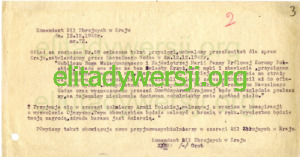 Działająca w konspiracji Armia Krajowa składała się wyłącznie z ochotników, w szczytowym okresie swego istnienia liczyła aż 390 tys. żołnierzy! Liczebnie była liczniejsza niż Wojsko Polskie na początku 1939. Była armią bez koszar. W 1944 służyło w niej 10,8 tys. oficerów, w większości żołnierzy zawodowych. Stanowiska dowódcze, na różnych szczeblach, obejmowały także osoby cywilne. Przy tej liczebności wojska brakowało zawodowej kadry dowódczej. Cichociemni mieli wydatnie pomóc w przygotowaniu i przeprowadzeniu powstania powszechnego w Kraju! Mieli wesprzeć realizację celu strategicznego oraz taktycznego AK.
Działająca w konspiracji Armia Krajowa składała się wyłącznie z ochotników, w szczytowym okresie swego istnienia liczyła aż 390 tys. żołnierzy! Liczebnie była liczniejsza niż Wojsko Polskie na początku 1939. Była armią bez koszar. W 1944 służyło w niej 10,8 tys. oficerów, w większości żołnierzy zawodowych. Stanowiska dowódcze, na różnych szczeblach, obejmowały także osoby cywilne. Przy tej liczebności wojska brakowało zawodowej kadry dowódczej. Cichociemni mieli wydatnie pomóc w przygotowaniu i przeprowadzeniu powstania powszechnego w Kraju! Mieli wesprzeć realizację celu strategicznego oraz taktycznego AK.
Celem władz polskich podczas II wojny światowej było odzyskanie niepodległości oraz odbudowa państwa w granicach co najmniej z sierpnia 1939, z przyłączeniem obszaru Prus Wschodnich, Gdańska, Pomorza i Śląska Opolskiego.
Celem strategicznym Armii Krajowej było przeprowadzenie w Polsce, w końcowej fazie wojny zwycięskiego powstania powszechnego. Celem taktycznym było prowadzenie walki bieżącej: wywiad, sabotaż, represje, dywersja. Według tajnego brytyjskiego raportu z 25 listopada 1941, w Związku Walki Zbrojnej służyło wówczas 121 tys. żołnierzy, w tym niespełna 3,8 tys. oficerów. Zaledwie 35 tys. miało broń…
Patryk Pleskot – W różnorodności siła. Pluralizm ideowy Armii Krajowej
w: Biuletyn informacyjny AK nr 2 (262) luty 2012, s. 25 – 29
Dywersja i wywiad
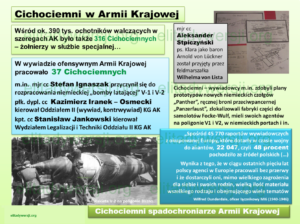 Działalność Armii Krajowej szczególnie koncentrowała się na dywersji, sabotażu oraz wywiadzie. W latach 1942 – 1945 oddziały żołnierzy Polski Walczącej przeprowadziły ponad 110 tys. akcji zbrojnych oraz dywersyjnych, w tym ponad 2,3 tys. na transport (m.in. wykolejono 1,3 tys. pociągów z wojskiem i uzbrojeniem). Zabito w walce ponad 150 tys. niemieckich żołnierzy i policjantów oraz kolaborantów.
Działalność Armii Krajowej szczególnie koncentrowała się na dywersji, sabotażu oraz wywiadzie. W latach 1942 – 1945 oddziały żołnierzy Polski Walczącej przeprowadziły ponad 110 tys. akcji zbrojnych oraz dywersyjnych, w tym ponad 2,3 tys. na transport (m.in. wykolejono 1,3 tys. pociągów z wojskiem i uzbrojeniem). Zabito w walce ponad 150 tys. niemieckich żołnierzy i policjantów oraz kolaborantów.
Wywiad AK m.in. zdobył informacje o konstrukcji oraz ustalił miejsce produkcji rakiet V1 i V2 w Peenemünde na wyspie Uznam. Najbardziej znaczącym sukcesem polskiego wywiadu było rozpracowanie niemieckiego systemu szyfrowania informacji, znanego jako Enigma. Już w 1942 Polacy dostarczyli dokumenty opisujące strukturę całości niemieckich sił lądowych i powietrznych.
W wywiadzie ofensywnym AK służyło 37 Cichociemnych, m.in. płk dypl. cc Kazimierz Iranek – Osmecki kierował wywiadem oraz kontrwywiadem AK; kpt. cc Stanisław Jankowski kierował Wydziałem Legalizacji i Techniki KG AK, mjr cc Stefan Ignaszak kierował rozpracowaniem tajnej niemieckiej „bomby latającej” V-1 i V-2.
„(…) wyrażam uznanie Armii Krajowej za dokonany wysiłek w ostatnim roku i zapewniam Pana, że uważamy ją dzisiaj za najlepiej zorganizowaną i najbardziej sprawną armię podziemną w Europie
gen. Collin Gubbins (SOE) w liście z 1 maja 1943 do gen. Tadeusza Klimeckiego (szef Sztabu Naczelnego Wodza)
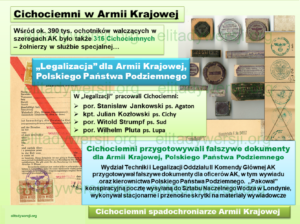 Wkład polskiego wywiadu w wysiłek aliantów 1945 ocenił oficer łącznikowy MI6 (1940-1946) komandor Wilfred Dunderdale – „spośród 45 770 raportów wywiadowczych z okupowanej Europy, które dotarły w czasie wojny do aliantów, 22 047, czyli 48 procent, pochodziło ze źródeł polskich. (…) Wynika z tego, że w ciągu ostatnich pięciu lat polscy agenci w Europie pracowali bez przerwy i że dostarczyli oni, mimo wielkiego zagrożenia dla siebie i swoich rodzin, wielką ilość materiału wszelkiego rodzaju i obejmującego wiele tematów”.
Wkład polskiego wywiadu w wysiłek aliantów 1945 ocenił oficer łącznikowy MI6 (1940-1946) komandor Wilfred Dunderdale – „spośród 45 770 raportów wywiadowczych z okupowanej Europy, które dotarły w czasie wojny do aliantów, 22 047, czyli 48 procent, pochodziło ze źródeł polskich. (…) Wynika z tego, że w ciągu ostatnich pięciu lat polscy agenci w Europie pracowali bez przerwy i że dostarczyli oni, mimo wielkiego zagrożenia dla siebie i swoich rodzin, wielką ilość materiału wszelkiego rodzaju i obejmującego wiele tematów”.
W 2004 oraz w 2005 opublikowano ustalenia Polsko-Brytyjskiej Komisji Historycznej pt. Polsko – brytyjska współpraca wywiadowcza podczas II wojny światowej, (wyd. Naczelna Dyrekcja Archiwów Państwowych, Warszawa 2004, 2005 ISBN 83-89115-11-5 oraz ISBN 83-89115-37-9. W 2005 brytyjski rząd oficjalnie potwierdził że ok. połowa tajnych raportów dla aliantów z okupowanej Europy pochodziła od Polaków.
Formacje dywersyjne
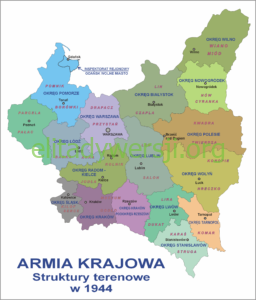 W trakcie swych działań AK tworzyła specjalne formacje dywersyjne: (20-04-1940) Związek Odwetu, (sierpień 1940) Wachlarz, (maj 1942) Organizację Specjalnych Akcji Bojowych Osa. 22 stycznia 1943 powołano Kierownictwo Dywersji (Kedyw) KG AK. Skupiał Związek Odwetu, Wachlarz, Tajna Organizację Wojskową oraz grupy bojowe Szarych Szeregów.
W trakcie swych działań AK tworzyła specjalne formacje dywersyjne: (20-04-1940) Związek Odwetu, (sierpień 1940) Wachlarz, (maj 1942) Organizację Specjalnych Akcji Bojowych Osa. 22 stycznia 1943 powołano Kierownictwo Dywersji (Kedyw) KG AK. Skupiał Związek Odwetu, Wachlarz, Tajna Organizację Wojskową oraz grupy bojowe Szarych Szeregów.
W czerwcu 1943 powołano Agat (akronim: anty-gestapo), którego dowódcą został Cichociemny, kpt. Adam Borys ps. Pług. W styczniu 1944 jednostka zmieniła nazwę na Pegaz (przeciw-gestapo), a w czerwcu 1944 na Parasol. Przeprowadziła wiele spektakularnych akcji, m.in. przeciwko hitlerowskim dygnitarzom, w tym zamach na kata Warszawy – Franza Kutscherę.
We wszystkich formacjach dywersyjnych walczyli Cichociemni – w Związku Odwetu walczyło 6 CC, zastępcą komendanta był jeden z Nich – mjr cc Henryk Krajewski ps. Trzaska. W „Wachlarzu” walczyło 27 Cichociemnych, połowa z zrzuconych wówczas do Polski. Dowodzili wszystkimi odcinkami „Wachlarza”. W „Kedywie” walczyło 146 Cichociemnych. Ponadto szkolili żołnierzy AK, m.in. w konspiracyjnej szkole dywersji Kedywu „Zagajnik”; jej komendantem był także Cichociemny ppłk cc Henryk Krajewski
Cichociemni
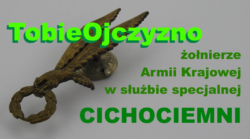 Cichociemni – byli wysokiej klasy specjalistami, przeszkolonymi w dywersji, sabotażu, łączności, wywiadzie – żołnierzami Armii Krajowej w służbie specjalnej. Tylko Cichociemni byli rekrutowani, selekcjonowani, szkoleni oraz ekspediowani do Polski przez Oddział VI (Specjalny) Sztabu Naczelnego Wodza. Wywodzili się z Polskich Sił Zbrojnych na Zachodzie pod dowództwem brytyjskim oraz Armii Polskiej gen. Andersa. Ochotniczo zgłosili się do służby w okupowanym kraju, po nieraz wielomiesięcznym przeszkoleniu specjalnym na wielu specjalistycznych kursach byli przerzucani drogą lotniczą do okupowanej Polski. Stanowili elitę wojskowych struktur Polskiego Państwa Podziemnego. Obejmowali w Armii Krajowej odpowiedzialne funkcje we wszystkich pionach oraz na rozmaitych szczeblach dowodzenia, z funkcją Dowódcy AK włącznie. Podstawowym zadaniem Cichociemnych było wsparcie Armii Krajowej w konspiracyjnej walce w okupowanej Polsce, także przygotowywanie powstania powszechnego, które planowano rozpocząć w ostatniej fazie wojny w Polsce oraz odtworzenie Sił Zbrojnych R.P. po wojnie – także w Polsce.
Cichociemni – byli wysokiej klasy specjalistami, przeszkolonymi w dywersji, sabotażu, łączności, wywiadzie – żołnierzami Armii Krajowej w służbie specjalnej. Tylko Cichociemni byli rekrutowani, selekcjonowani, szkoleni oraz ekspediowani do Polski przez Oddział VI (Specjalny) Sztabu Naczelnego Wodza. Wywodzili się z Polskich Sił Zbrojnych na Zachodzie pod dowództwem brytyjskim oraz Armii Polskiej gen. Andersa. Ochotniczo zgłosili się do służby w okupowanym kraju, po nieraz wielomiesięcznym przeszkoleniu specjalnym na wielu specjalistycznych kursach byli przerzucani drogą lotniczą do okupowanej Polski. Stanowili elitę wojskowych struktur Polskiego Państwa Podziemnego. Obejmowali w Armii Krajowej odpowiedzialne funkcje we wszystkich pionach oraz na rozmaitych szczeblach dowodzenia, z funkcją Dowódcy AK włącznie. Podstawowym zadaniem Cichociemnych było wsparcie Armii Krajowej w konspiracyjnej walce w okupowanej Polsce, także przygotowywanie powstania powszechnego, które planowano rozpocząć w ostatniej fazie wojny w Polsce oraz odtworzenie Sił Zbrojnych R.P. po wojnie – także w Polsce.
W strukturach dowodzenia Armii Krajowej służyło bardzo wielu Cichociemnych – w Komendzie Głównej AK aż 92 CC (w tym komendant główny gen. cc Leopold Okulicki. 8 CC było komendantami lub zastępcami komendantów Okręgów AK, 7 CC szefami sztabów. Ponadto kilkudziesięciu Cichociemnych pełniło funkcje dowódcze w Komendach Obszarów i Okręgów AK, w strukturach Kedywu w obszarach i okręgach, byli także dowódcami oddziałów dyspozycyjnych KG AK oraz oddziałów partyzanckich AK. 169 Cichociemnych walczyło w dywersji i partyzantce, 37 w wywiadzie AK, 24 w sztabach, 22 w służbach lotniczych. Cała sieć łączności Armii Krajowej oparta była na służbie 50 Cichociemnych pracujących na polskich radiostacjach typu AP. 11 Cichociemnych miało specjalność pancerną, 3 legalizacji czyli fałszowania dokumentów. W Powstaniu Warszawskim walczyło 95 Cichociemnych.
Cichociemni w Armii Krajowej, nie byli formalnie istniejącą jednostką, stali się prekursorami współczesnych jednostek specjalnych. Działania powietrznodesantowe, operacje specjalne, przeprowadzane z użyciem specjalnie wyszkolonych, elitarnych formacji komandosów, są obecnie kluczowym elementem wszelkich strategii oraz doktryn militarnych na świecie. W Polsce Ich tradycje kontynuuje Jednostka Wojskowa GROM.
Kazimierz Iranek-Osmecki – Charakter i oblicze polskiego podziemia wojskowego
Londyn 1951 r. w: Biuletyn informacyjny AK nr 2 (262) luty 2012, s. 14 – 24
Status prawny Armii Krajowej
Związek Walki Zbrojnej, później Armia Krajowa miał dosyć specyficzny status prawny. Niektórzy historycy błędnie uważają AK za integralną część Polskich Sił Zbrojnych na Zachodzie, a nawet stawiają między nimi znak równości, wprowadzając do publicznego obiegu termin PSZ/AK. Niektórzy politycy akceptują publicznie nawet oczywistą bzdurę, jakoby Cichociemni żołnierze Armii Krajowej rzekomo „stali na czele alianckich operacji wojennych”. To błędne uproszczenia.
Wszyscy żołnierze (w czynnej służbie wojskowej) w okupowanej Polsce stanowili Armię Krajową (choć nie wszyscy się podporządkowali AK, nie wszystkie organizacje scalono) i podlegali dowódcy AK (a nie bezpośrednio Naczelnemu Wodzowi, dowodzącemu PSZ na Zachodzie). Oczywiście dotyczyło to także Cichociemnych.
Dowódca Armii Krajowej miał wobec żołnierzy Armii Krajowej uprawnienia Naczelnego Wodza do czasu przybycia na terytorium RP NW funkcjonującego na obczyźnie – stanowił tak dekret Prezydenta RP z 1 września 1942 „O tymczasowej organizacji władz na ziemiach Rzeczpospolitej” (powtórzony ze zmianami 26 kwietnia 1944). Polscy żołnierze w okupowanej Polsce byli zatem żołnierzami Armii Krajowej, a nie żołnierzami PSZ; podlegali dowódcy AK. Z dekretu nie wynika, aby AK była częścią PSZ, natomiast wynika, że Dowódca AK podlegał Naczelnemu Wodzowi w Londynie (nota bene, był przezeń wyznaczony).
Art. 12 ust. 1 dekretu Prezydenta R.P. stanowił:
„Na czas nieobecności Naczelnego Wodza dowództwo Sił Zbrojnych na ziemiach Rzeczpospolitej sprawuje wyznaczony przez Naczelnego Wodza i podległy jemu bezpośrednio Komendant Sił Zbrojnych w Kraju”.
Droga do ostatecznego przyjęcia tego dekretu znakomicie ilustruje realność „dowodzenia Armią Krajową” przez Naczelnego Wodza w Londynie – otóż Prezydent RP podpisał ten dekret 1 września 1942, w październiku1942 został wysłany do Delegata Rządu na Kraj, po otrzymaniu poprawek z okupowanej Polski dekret został wydany… 26 kwietnia 1944, tj. po prawie dwudziestu miesiącach…
Dowódca Armii Krajowej dysponował niezwykle szeroką autonomią działania. W praktyce dowodził AK samodzielnie, choć wykonywał rozkazy Naczelnego Wodza. Jego „autonomia” była głównie efektem realistycznego podejścia, tj. ówczesnej technicznej niemożliwości bezpośredniego dowodzenia z zagranicy – zwłaszcza na poziomie operacyjnym – konspiracyjnymi strukturami w okupowanym kraju.
Pośrednio tą autonomię dowódcy Armii Krajowej podkreślał także status Oddziału VI (Specjalnego) Sztabu Naczelnego Wodza w Londynie, który był niejako „ambasadą AK” w sztabie Naczelnego Wodza. Był on bowiem INSTYTUCJĄ ŁĄCZNIKOWĄ pomiędzy Naczelnym Wodzem a Dowódcą Armii Krajowej. Warto w tym kontekście zauważyć, że początkowo nawet nosił nazwę „Samodzielny Wydział Krajowy”.
Jak podkreśla jeden z jego szefów płk dypl Marian Utnik:
„W stosunku do konspiracyjnych organizacji wojskowych w Polsce gen. Sosnkowski był komendantem głównym ZWZ, a w kraju byli jego podkomendni (…) Oddział VI spełniał więc rolę sztabu operacyjnego komendanta głównego ZWZ”. Po agresji Niemiec na ZSRR zasadniczo zmieniły się „rola i zadanie Oddziału VI, który z organu dowodzenia stał się w zasadzie organem łącznikowym komendanta głównego AK przy naczelnym wodzu w Londynie (…) Jako łącznik między konspiracją wojskową w Polsce a Sztabem NW w Londynie Oddział VI wykonywał wiele prac, z których jedne cechuje charakter stały, a inne okresowy lub tylko jednorazowy.
(Marian Utnik – Oddział łącznikowy Komendanta Głównego AK przy Naczelnym Wodzu na emigracji (VI Oddział Sztabu Naczelnego Wodza) część I, w: Wojskowy Przegląd Historyczny, Warszawa 1981, nr 3 s. 130-158)
Naczelny Wódz dopiero 3 września 1941 (po dwóch latach okupacji) w depeszy do ZWZ oraz Delegata Rządu Na Kraj stwierdził, że UWAŻA organizację wojskową w Kraju za część dowodzonych przez siebie Polskich Sił Zbrojnych. Z formalnoprawnego punktu widzenia depesza NW nie może być uznana za źródło prawa, nawet w ówczesnej wojennej sytuacji. Z jej treści wynika, iż Naczelny Wódz wyraził tylko osobisty pogląd.
Przed przystąpieniem AK do realizacji Akcji Burza, dowódca AK wystąpił do Naczelnego Wodza, aby alianci uznali Armię Krajową za część składową sił sprzymierzonych. Pomimo sprzeciwu ZSRR zachodni alianci: USA oraz Wielka Brytania zareagowali przychylnie. W deklaracji brytyjskiej z 29 sierpnia 1944, ogłoszonej na antenie radiowej BBC, stwierdzono, że „Polska Armia Krajowa obecnie zmobilizowana stanowi siłę kombatancką, będącą integralną częścią Polskich Sił Zbrojnych”. Polityczne deklaracje na antenie radiowej państw obcych, choć sojuszniczych, nie mogą być jednak uznane za źródło polskiego prawa, nawet w wojennej rzeczywistości. Statusu AK jako części PSZ nie uznawali: ZSRR oraz Niemcy, którzy jednak wyjątkowo respektowali go jedynie wobec części żołnierzy AK idących do niewoli po kapitulacji Powstania Warszawskiego. Częściowo respektowali, z obawy o traktowanie przez aliantów niemieckich jeńców wojennych…
Reasumując, konspiracyjna organizacja wojskowa w okupowanej Polsce – Armia Krajowa – była strukturą podległą Dowódcy AK, zaś dowódca AK miał wobec niej uprawnienia Naczelnego Wodza, choć sam jemu podlegał. Status żołnierzy AK potwierdza rozkaz Naczelnego Wodza (znoszący nazwę ZWZ) z 14 lutego 1942, w którym czytamy m.in. – „Wszyscy żołnierze w czynnej służbie wojskowej w Kraju stanowią Armię Krajową (…)”. 15 sierpnia 1942 Naczelny Wódz gen. Władysław Sikorski zarządził podporządkowanie Dowódcy AK wszystkich organizacji wojskowych działających na terenie Polski. Jak zauważa prof. Marek Ney-Krwawicz, na podstawie art. 13 Dekretu Prezydenta R.P. z 27 maja 1942 „O organizacji najwyższych władz wojskowych” dowódca AK dowodził Siłami Zbrojnymi w Kraju i kierował całością operacji wojskowych w Kraju.” (Armia Krajowa – podziemne Wojsko Polskie, w: Zeszyt Naukowy Muzeum Wojska 1989, nr 3 s. 120-121)
Z treści dekretu Prezydenta RP, także statusu prawnego Oddziału VI (Specjalnego), ustanowionego przecież legalnym rozkazem Naczelnego Wodza jasno wynika, że Armia Krajowa była strukturą wojskową odrębną od Polskich Sił Zbrojnych na Zachodzie (choć przez Sztab Naczelnego Wodza wspieraną) oraz podlegała jedynie swojemu Dowódcy. Komendant Główny Armii Krajowej w okupowanej Polsce podlegał Naczelnemu Wodzowi w Londynie, ale w praktyce miał niezwykle szeroką autonomię w dowodzeniu AK.
Teza o AK jako rzekomej „części” Polskich Sił Zbrojnych pod dowództwem brytyjskim formowana była (nadal jest) na użytek polityczny i jest prawnym nonsensem. Status PSZ w Wielkiej Brytanii regulowała umowa z 5 sierpnia 1940 pomiędzy rządami: Wielkiej Brytanii oraz R.P., zatwierdzona przez brytyjski parlament 22 sierpnia 1940 ustawą Allied Forces Act. Art. 1 tej umowy stwierdzał jednoznacznie, że Polskie Siły Zbrojne (składające się z sił lądowych, morskich i powietrznych) zostaną zorganizowane pod dowództwem brytyjskim jako siły sprzymierzone. W tej umowie nie ma słowa o Armii Krajowej. Poza przywołanym wcześniej dekretem Prezydenta R.P. – określającym rzeczywisty status prawny Armii Krajowej – nie istnieje żaden akt prawny, który miałby sytuować Armię Krajową jako „część PSZ”. Naczelny Wódz mógł wygłaszać na ten temat różne opinie, podobnie różne (polityczne) deklaracje mogli składać przedstawiciele rządów obcych państw. Jednak ani deklaracje Naczelnego Wodza, ani deklaracje przedstawicieli jakichkolwiek obcych rządów nie były i nie mogą być uznane za źródło polskiego prawa (za podstawę prawną), nawet w realiach wojennych…
Reasumując – Armia Krajowa była częścią Sił Zbrojnych, podległych Naczelnemu Wodzowi (podlegała NW pośrednio, poprzez podległość dowódcy AK). Propagandyści twierdzący, że Armia Krajowa była rzekomo „częścią Polskich Sił Zbrojnych na Zachodzie” powinni konsekwentnie przyjąć za prawdziwe bzdurne twierdzenie, że w takim razie Armia Krajowa znajdowała się również pod dowództwem brytyjskim…
Cichociemni byli żołnierzami Armii Krajowej w służbie specjalnej.
Żołnierzami PSZ byli wcześniej, przed przerzutem do Polski…
Marek Ney-Krwawicz – Polskie Państwo Podziemne. Aspekty wojskowe
w: Polski wiek XX: II wojna światowa
Bellona i Muzeum Historii Polski, Warszawa 2010, s. 119-154
Finanse Armii Krajowej
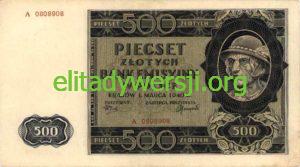
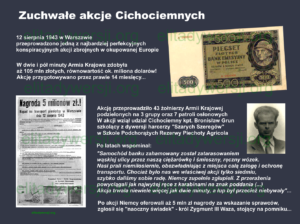 Działalność Armii Krajowej finansowana była początkowo (do końca 1941) z kasy polskiego Ministerstwa Skarbu w Londynie, do Polski przerzucono w tym okresie ok. 100 tys. dolarów. Od wiosny 1940 do końca 1942 w kontrolowanej przez Niemców Polskiej Wytwórni Papierów Wartościowych w Warszawie, produkującej dla niemieckiego okupanta banknoty i inne dokumenty, funkcjonowała konspiracyjna organizacja – Podziemna Wytwórnia Banknotów (PWB). Grupa pracowników PWPW, dowodzona przez ppor. Czesława Lecha ps. Biały, na potrzeby Polskiego Państwa Podziemnego produkowała w konspiracji banknoty, dokumenty legalizacyjne, kartki żywnościowe, talony na obuwie itp. Według historyków, do końca 1942 PWB „wyprodukowała” dla AK (właściwie przejęła z produkcji PWPW dla Niemców) aż ok. 18 milionów (!!!) „młynarek” (potoczna nazwa banknotów od nazwiska prezydenta Banku Emisyjnego w Polsce Feliksa Młynarskiego). 12 sierpnia 1943 Armia Krajowa zdobyła w akcji „Góral” aż ok. 105 mln zł, równowartość ok. miliona dolarów po czarnorynkowym kursie. W lipcu 1943 przez kuriera dostarczono do Wielkiej Brytanii klisze banknotów 50, 100 i 500 zł, próby papierów, znaków wodnych oraz farb, co umożliwiło wyprodukowanie w ośrodku SOE – STS 38 w Briggens (Wielka Brytania) ok. 50 mln okupacyjnych złotych dla Armii Krajowej.
Działalność Armii Krajowej finansowana była początkowo (do końca 1941) z kasy polskiego Ministerstwa Skarbu w Londynie, do Polski przerzucono w tym okresie ok. 100 tys. dolarów. Od wiosny 1940 do końca 1942 w kontrolowanej przez Niemców Polskiej Wytwórni Papierów Wartościowych w Warszawie, produkującej dla niemieckiego okupanta banknoty i inne dokumenty, funkcjonowała konspiracyjna organizacja – Podziemna Wytwórnia Banknotów (PWB). Grupa pracowników PWPW, dowodzona przez ppor. Czesława Lecha ps. Biały, na potrzeby Polskiego Państwa Podziemnego produkowała w konspiracji banknoty, dokumenty legalizacyjne, kartki żywnościowe, talony na obuwie itp. Według historyków, do końca 1942 PWB „wyprodukowała” dla AK (właściwie przejęła z produkcji PWPW dla Niemców) aż ok. 18 milionów (!!!) „młynarek” (potoczna nazwa banknotów od nazwiska prezydenta Banku Emisyjnego w Polsce Feliksa Młynarskiego). 12 sierpnia 1943 Armia Krajowa zdobyła w akcji „Góral” aż ok. 105 mln zł, równowartość ok. miliona dolarów po czarnorynkowym kursie. W lipcu 1943 przez kuriera dostarczono do Wielkiej Brytanii klisze banknotów 50, 100 i 500 zł, próby papierów, znaków wodnych oraz farb, co umożliwiło wyprodukowanie w ośrodku SOE – STS 38 w Briggens (Wielka Brytania) ok. 50 mln okupacyjnych złotych dla Armii Krajowej.
W kwietniu 1942 amerykański prezydent Franklin Delano Roosevelt przekazał dla krajowych organizacji konspiracyjnych 1,5 mln dolarów dotacji. W lutym 1943 prezydent USA przekazał na potrzeby polskiej konspiracji dotację w wysokości 2,5 mln dolarów; w czerwcu 1944 rząd londyński otrzymał 10 mln dolarów amerykańskiej dotacji. Brytyjskie SOE zadaniowało wywiad AK, otwierając na operację „Big Scheme” (Wachlarz) ok. 3 mln dolarów kredytu. Od stycznia 1944 do końca marca 1945 brytyjski wywiad – Intelligence Service przekazywał za pośrednictwem Oddziału II (wywiad) Sztabu Naczelnego Wodza 0,5 mln dolarów kwartalnej dotacji na prowadzenie polskiego wywiadu; łącznie przekazano ok. 3 mln dolarów. Wszystkie dotacje w dolarach i złocie z przeznaczeniem do wysyłki do okupowanej Polski wyniosły łącznie ok. 20 mln dolarów; część z tego przekazano Delegaturze Rządu na Kraj.
Głównym źródłem finansowania AK były właśnie te środki finansowe, przekazywane do Kraju początkowo przez kurierów trasami lądowymi (ok. 12 proc.), po uruchomieniu zrzutów drogą lotniczą przez Cichociemnych. Później waluty obce przerzucano głównie drogą lotniczą, natomiast okupacyjne złotówki w większości trasami lądowymi. Pieniądze ze zrzutów docierały do Oddziału IV (kwatermistrzostwo) Komendy Głównej AK dopiero po kilku tygodniach. Kwoty w obcych walutach wymagały powolnej wymiany na „czarnym rynku”, aby nie doprowadzić do obniżki cen. Ogółem przerzucane przez kurierów oraz Cichociemnych kwoty nie wystarczały na wszystkie potrzeby.
Budżet ZWZ w 1941 wynosił ok. 517 tys. USD, w 1942 wydatki oszacowano na kwotę 4 mln USD! W 1943 budżet AK wynosił ok. 10 mln USD, w 1944 ok. 20 mln USD (Studium Polski Podziemnej – Armia Krajowa w dokumentach 1939-1945, wyd. Gryf Printers, Londyn 1990, t. II, s. 147; Instrukcja nr 10, w: Armia Krajowa w dokumentach, t. II, s. 175).
Grzegorz Rutkowski – Środki pieniężne przerzucone drogą lotniczą
dla Polskiego Państwa Podziemnego
w: Dzieje Najnowsze 2018, nr 2, s. 5 – 20
Przygotowanie powstania powszechnego w Polsce
Idea przeprowadzenia w Kraju powszechnego powstania zbrojnego, mającego bezpośrednio poprzedzić wkroczenie na terytorium R.P. regularnych wojsk polskich, pojawiła się już w listopadzie 1939. Przygotowaniami w okresie francuskim zajmowało się tzw. Biuro generała Sosnkowskiego. Pod tą kamuflażowa nazwą funkcjonowała Komenda Główna ZWZ, kierowana przez dowódcę ZWZ gen. broni Kazimierza Sosnkowskiego.
W ostatniej dekadzie grudnia 1939 odbyła się pierwsza wewnętrzna konferencja KG ZWZ w Paryżu, w sprawie przyszłego powstania powszechnego, z udziałem m.in. płk. dypl. Stanisława Sosabowskiego. 30 grudnia 1939 kpt. Jan Górski skierował do gen. Sosnkowskiego swój pierwszy raport w sprawie utworzenia lotniczej łączności z Krajem. Przygotował opracowanie pt. „Użycie lotnictwa dla łączności i transportów wojskowych drogą powietrzną do Kraju oraz dla wsparcia powstania. Stworzenie jednostek wojsk powietrznych”. Wobec braku reakcji ponowił raport 21 stycznia 1940.
Wreszcie 14 lutego 1940 wraz z kpt. Maciejem Kalenkiewiczem złożyli w tej sprawie trzeci raport. Kpt. Jan Górski podkreślał w nim: „Głównym zadaniem wojsk polskich we Francji jest jak najwydajniejsze i jak najbardziej bezpośrednie działanie na korzyść Kraju. Taką właśnie jego formą jest wsparcie powstania przez desanty oddziałów wojsk polskich tworzonych we Francji.”
W kwietniu 1940 kpt. Kalenkiewicz opracował „Plan wsparcia i osłony powstania w Kraju„. W ostatniej dekadzie kwietnia 1940 obaj kapitanowie zostali przeniesieni do „Biura gen. Sosnkowskiego”, gdzie pracowali nad planami wsparcia drogą lotniczą powstania powszechnego. W maju złożyli do Sztabu Naczelnego Wodza memorandum w tej sprawie.
29 czerwca 1940, po rozwiązaniu dotychczasowej komendy Głównej ZWZ na obczyźnie, z części jej składu utworzono w sztabie Naczelnego Wodza Samodzielny Wydział Krajowy, ze względów bezpieczeństwa nazywany Odziałem VI, potem Oddziałem Specjalnym Sztabu NW. 10 października 1940 Naczelny Wódz Polskich Sił Zbrojnych gen. Władysław Sikorski wydał rozkaz L.408/III w sprawie przygotowania Polskich Sił Zbrojnych do możliwości przerzucenia transportem lotniczym do kraju, do bezpośredniego wsparcia i osłony Powstania.
Brytyjski wywiad wojskowy MI (R) w swoim raporcie dla War Office z 17 lipca 1940 nt. krótko- i długoterminowej strategii współpracy z Polakami uznał możliwość wywołania powstania powszechnego w Polsce, zalecając nawiązanie ścisłej współpracy pomiędzy brytyjskim wywiadem wojskowym a Oddziałem II Sztabu Naczelnego Wodza. Więcej info – Powstanie niezbyt powszechne
W marcu 1941 kpt. Jan Górski oraz kpt. Maciej Kalenkiewicz przedłożyli studium strategiczne – Uderzenie powierzchniowe [powietrznodesantowe] jako nowa forma walki zaczepnej.
Komenda Główna AK w dokumencie „Zasady walki powstańczej” podkreślała:
powstanie musi charakteryzować długotrwałe, precyzyjne w szczegółach przygotowanie, a następnie krótkie, gwałtowne, powszechne i jednoczesne uderzenie, które poprzez postawienie wszystkiego na jedną kartę i działanie niezwykle śmiałe powinno doprowadzić do rozstrzygnięcia w ciągu niewielu godzin powstańczej nocy.”
Meldunek Operacyjny nr 54
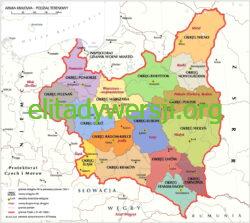 Pierwszy plan powstania powszechnego, jako „Meldunek Operacyjny nr 54” w zaszyfrowanej postaci w lutym 1941 wysłano do Sztabu Naczelnego Wodza w Londynie. Gdy „Meldunek” był opracowywany, Polska była okupowana przez hitlerowców i sowietów. Gdy dotarł do Sztabu NW, Niemcy napadły na ZSRR (22 czerwca 1941). Nawiązanie współpracy wojskowej pomiędzy Wielką Brytanią a ZSRR (w tym także pomiędzy SOE a NKWD) spowodowało faktyczne zaniechanie planu wsparcia powstania w Polsce oraz zmniejszenie pomocy militarnej dla Armii Krajowej.
Pierwszy plan powstania powszechnego, jako „Meldunek Operacyjny nr 54” w zaszyfrowanej postaci w lutym 1941 wysłano do Sztabu Naczelnego Wodza w Londynie. Gdy „Meldunek” był opracowywany, Polska była okupowana przez hitlerowców i sowietów. Gdy dotarł do Sztabu NW, Niemcy napadły na ZSRR (22 czerwca 1941). Nawiązanie współpracy wojskowej pomiędzy Wielką Brytanią a ZSRR (w tym także pomiędzy SOE a NKWD) spowodowało faktyczne zaniechanie planu wsparcia powstania w Polsce oraz zmniejszenie pomocy militarnej dla Armii Krajowej.
Sztab Naczelnego Wodza przez pewien czas nie miał świadomości zmiany brytyjskich priorytetów. Dla zrealizowania przygotowywanego powstania, przygotowywano reorganizację Polskich Sił Powietrznych. Planowano do końca 1942 utworzenie 12 dywizjonów myśliwskich oraz 4 dywizjony bombowców nurkujących.
Istotnym elementem planu było przygotowanie 2-3 batalionów oddziałów specjalnych. Część z nich miała wylądować w Polsce jeszcze przed wybuchem powstania. Wśród nich miały być:
- zaporowe oddziały minerskie, wysadzające drogi i linie kolejowe oraz instalujące zapory przeciwczołgowe
- specjalne oddziały szturmowe, wyspecjalizowane w przejmowaniu oraz niszczeniu lotnisk i obiektów lotniczych
- partyzanckie oddziały dywersyjne, niszczące łączność oraz kluczowe obiekty wojskowe
- oddziały łączności, zapewniające sprawny system dowodzenia wojskami powstańczymi
W „Meldunku Operacyjnym nr 54” zaplanowano zrzucenie przynajmniej po jednym batalionie spadochroniarzy w 4 kluczowych dla sukcesu powstania obszarach Polski, tzw. bazie. Były to polskie ziemie etniczne z silnie rozwiniętą konspiracją wojskową: teren GG (bez Galicji Wschodniej), Zagłębie Dąbrowskie, dawne województwo łódzkie, ziemia płocka, zachodnia część dawnego województwa białostockiego oraz rejon Brześcia nad Bugiem. Za niezbędny warunek sukcesu powstania uznano opanowanie obszaru pomiędzy Warszawą, Łodzią, Krakowem, Rzeszowem i Lublinem oraz opanowanie najważniejszych ośrodków, tzw. ognisk walki, tj. celów istotnych dla oporu lub dla powstania. Więcej info – Powstanie niezbyt powszechne
27 grudnia 1941 mjr dypl. cc Jan Górski w swoim pamiętniku zanotował:
Nasz polski pogląd na sposób przeprowadzenia głównej rozgrywki wojennej z Niemcami został dwukrotnie aprobowany przez N.W. [Naczelnego Wodza] i zatwierdzony jego podpisami w rozkazach 408/II tj. 40 oraz 841/III tj. 41.1 (red: wszystkie siły na powstanie powszechne przeznaczyć!).
Rozkazy te wymagają dużego wysiłku w celu doprowadzenia do ich realizacji. Powstaje zagadnienie natury strategicznej wymagające tak samo jednolitego kierownictwa i doboru najlepszych naszych sił. W ramach całego wysiłku anglo-amerykańskiego, europejska kampania kontynentalna odegra bez wątpienia najpoważniejszą rolę. Sposób przeprowadzenia tej kampanii ujęły wyżej wymienione rozkazy. Do dziś dnia nie wysuwa się innego poglądu na tę sprawę. Chyba wśród tych, co widzą rozwiązanie w zwycięstwie Rosji (…) tak na prawdę rozpacz, że rozkazy są, ale działania?
niepublikowane, źródło: archiwum rodzinne Michała Górskiego Dziękujemy za wyrażenie zgody na publikację na naszym portalu.
Raport Operacyjny nr 154
Po agresji hitlerowskiej na Rosję, KG AK opracowała zmodyfikowany plan powstania, znany jako „Raport Operacyjny nr 154”. Wysłano go do Londynu we wrześniu 1942, zawierał także postulaty dotyczące wykorzystania lotnictwa na potrzeby przygotowywanego powstania.
26 lutego 1943 Szef Sztabu Naczelnego Wodza zatwierdził wariant nr 2 planu Lotniczego Wsparcia Powstania. W marcu 1943 Raport Operacyjny 154 został rozszyfrowany w Sztabie Naczelnego Wodza. W oparciu o niego przygotowano dla Naczelnego Wodza referat streszczający istotę planu.
Po tragicznej śmierci gen. Sikorskiego nie zmalało w Sztabie Naczelnego Wodza tempo przygotowań do lotniczego wsparcia powstania powszechnego w Kraju. Prowadzono je w porozumieniu z Dowództwem Armii Krajowej. Z planem powstania połączono plan OSZ, czyli Odtwarzania Sił Zbrojnych.
W 1943, po przełomie stalingradzkim na froncie wschodnim, w sytuacji pogarszania się stosunków radziecko – polskich, w tym wobec ujawnienia w kwietniu 1943 grobów polskich oficerów w Katyniu, kwestionowania granicy wschodniej przez ZSRR, dowództwo AK sygnalizowało potrzebę zmiany koncepcji powstania. Miałoby ono być przeprowadzane strefami, poczynając od wschodu. Wyodrębniono dwie strefy: od Wilna po Lwów oraz na terenach od linii Białystok – Brześć – Bug – San, na których wybuch powstania miał być zależny od wkraczania wojsk sowieckich.
Dla przygotowania planowanego powstania powszechnego w okupowanej Polsce założono zrzucenie 300 zestawów zasobników OW („Ognisko Walki”) oraz 40 zestawów MD (minersko – dywersyjnych); łącznie ok. 200 ton zaopatrzenia. Założono straty w zrzutach ok. 25 proc. (85 zestawów), czyli łącznie zapotrzebowano 425 zestawów zasobników, co wymagało 450 lotów z zaopatrzeniem.
Planowano że możliwe będzie wykonanie ok. 200 lotów w operacjach specjalnych SOE. Plan zakładał zrzucenie także w tych operacjach ok. 800 spadochroniarzy (po 4 skoczków w każdej operacji). Pozostałe 250 lotów miało być zorganizowane dzięki pomocy amerykańskiej, w 3-4 operacjach masowych zrzutów z ok. 30-40 samolotów (8-12 zasobników na samolot). Wszystkie te plany pokrzyżowała prosowiecka postawa brytyjskiego Foreign Office (od którego było zależne SOE)… Więcej info – Powstanie niezbyt powszechne
Marek Ney-Krwawicz – Organizacja prac nad powstaniem powszechnym w kraju
w Sztabie Naczelnego Wodza na obczyźnie. Zarys problemu
Kwartalnik Historyczny, Warszawa 1995, tom 102, nr 2-3 s. 197-208, ISSN 0023-5903
Instrukcja dla Kraju
26 października 1943 rząd R.P. kierowany przez Naczelnego Wodza przyjął „Instrukcję dla Kraju”, w której przewidywano dwie alternatywy powstania:
- „Rząd Polski po uzgodnieniu z Aliantami dochodzi do przekonania, że należy dać rozkaz do powstania”, jego głownym celem ma być „opanowanie jak największego obszaru Rzeczypospolitej, jako podstawy do przywrócenia na ziemiach Polski suwerenności Państwa Polskiego i odtworzenia Sił Zbrojnych w Kraju”
- w przypadku braku zgody aliantów, w sytuacji załamania niemieckiego frontu, wezwanie Kraju „do wzmożonej akcji sabotażowo-dywersyjnej przeciw Niemcom. Akcja ta jednak ma wtedy tylko charakter polityczno – demostracyjny i ochronny„.
W „Instrukcji” przyjęto, że:
- w przypadku nawiązania stosunków dyplomatycznych z ZSRR, rząd miał ujawnić administrację podziemną Polski, odtwarzać Polskie Siły Zbrojne oraz współpracować z Sowietami. W przypadku „przywracania (…) stanu bezprawnej inkorporacji” na ziemiach wschodnich [nie przewidziano inkorporacji całej Polski – przyp. RMZ] rząd miał złożyć protest „u Narodów Zjednoczonych„.;
- w przypadku braku stosunków dyplomatycznych z ZSRR, wkroczenie wojsk sowieckich miały poprzedzać wystąpienia zbrojne przeciwko Niemcom. W razie sowieckich aresztowań „przedstawicieli ruchu podziemnego” oraz represji wobec Polaków, organizacje podziemne miały „przejść do akcji samoobrony„.
W obu w/w przypadkach zastrzeżono, że „wystąpienia czynne [czytaj: zbrojne – przyp. RMZ} należy ograniczyć do niezbędnych aktów samoobrony”.
„Instrukcja” przewidywała także dość surrealistyczny wariant „porozumienia niemiecko-sowieckiego”, naiwnie zalecając – „władze Krajowe i Siły Zbrojne w Kraju schodzą głębiej pod ziemię, zawieszają działania zbrojne, z wyjątkiem najkonieczniejszych aktów samoobrony i oczekują na dalsze decyzje Rządu, rezerwując swe siły do ostatecznego zrywu w momencie zbliżania się Armii Alianckich„.
Zauważano także, że „postulat przewiezienia naszych wojsk spadochronowych do Kraju może być utrzymany jako słuszny, aczkolwiek stanowi on tylko szczegół nie wpływający zasadniczo na warunki uruchomienia powstania„.
Uwagi Naczelnego Wodza oraz Instrukcja dla Kraju z 26 października 1943
w: dokumenty Sztabu Naczelnego Wodza i Ministerstwa Spraw Wojskowych / MON
źródło: Instytut Polski i Muzeum im. gen. Sikorskiego sygn. A.XII.1/39 s. 8-10
Jeszcze 27 listopada 1944 szef Sztabu Naczelnego Wodza gen. Stanisław Kopański pisał w depeszy do gen. Leopolda Okulickiego – „Prawdopodobieństwo ogólnego powstania na ziemiach polskich pod okupacją niemiecką w obecnych warunkach coraz bardziej maleje, niemniej jednak nie może być całkowicie wykluczone, toteż nie może być wyeliminowane z przygotowań AK.
Prace sztabowe nad planami wsparcia powstania powszechnego w Kraju, prowadzone w Sztabie Naczelnego Wodza na obczyźnie, stanowiły duże przedsięwzięcie, angażujące w różnym stopniu prawie wszystkie oddziały Sztabu NW i Inspektorat Polskich Sił Powietrznych. (…) Prace te były istotnym fragmentem polskiej myśli wojskowej lat II wojny światowej, a z koncepcji wsparcia powstania oddziałami desantowymi narodziła się pierwsza w historii naszej armii jednostka powietrznodesantowa, jaką była 1 Samodzielna Brygada Spadochronowa, organizowana z myślą o wsparciu krajowego powstania powszechnego.
Marek Ney-Krwawicz, Organizacja prac nad powstaniem powszechnym w kraju w Sztabie Naczelnego Wodza na obczyźnie. Zarys problemu, Kwartalnik Historyczny, 102 (3-4), Warszawa 1995, s. 197?208, ISSN 0023-5903
Podstawowym zadaniem Cichociemnych było wsparcie Armii Krajowej w konspiracyjnej walce w okupowanej przez Niemców i Sowietów Polsce, także przygotowywanie powstania powszechnego, które planowano rozpocząć w ostatniej fazie wojny w Polsce oraz odtworzenie Sił Zbrojnych R.P. po wojnie – także w Polsce. Więcej info – Powstanie niezbyt powszechne
Akcja Burza
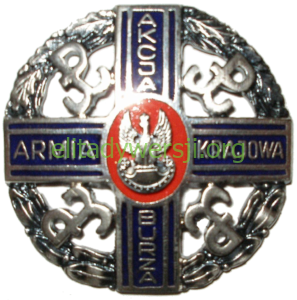 W rozkazie z 20 listopada 1943 Dowódca AK nakazał przeprowadzenie Akcji Burza, czyli operacji wojskowej AK przeciwko Niemcom, prowadzonej bezpośrednio przed wkroczeniem na terytorium II Rzeczypospolitej Armii Czerwonej. Zgodnie z rozkazem, oddziały AK miały nękać oddziały niemieckie oraz koncentrować się na działaniach dywersyjnych, szczególnie na trasach komunikacyjnych. Zakazano działań zbrojnych przeciwko Rosjanom, poza niezbędnymi aktami samoobrony.
W rozkazie z 20 listopada 1943 Dowódca AK nakazał przeprowadzenie Akcji Burza, czyli operacji wojskowej AK przeciwko Niemcom, prowadzonej bezpośrednio przed wkroczeniem na terytorium II Rzeczypospolitej Armii Czerwonej. Zgodnie z rozkazem, oddziały AK miały nękać oddziały niemieckie oraz koncentrować się na działaniach dywersyjnych, szczególnie na trasach komunikacyjnych. Zakazano działań zbrojnych przeciwko Rosjanom, poza niezbędnymi aktami samoobrony.
Po wkroczeniu na dany teren oddziałów Armii Czerwonej, według tego rozkazu AK miała występować jako gospodarz. „Miejscowy dowódca polski winien zgłosić się wraz z mającym się ujawnić przedstawicielem cywilnej władzy administracyjnej u dowódcy oddziałów sowieckich i stosować się do jego życzeń„.
Operacja „Burza” trwała od momentu przekroczenia przez Armię Czerwoną granicy polsko-radzieckiej z 1939, tj. na Wołyniu od 4 stycznia 1944 do stycznia 1945. Wzięło w niej udział ok. 100 tys. żołnierzy i oficerów. Więcej informacji o tej operacji – na stronie Akcji Burza.
Powstanie Warszawskie
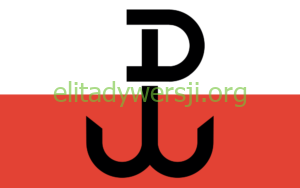 Było jednym z najważniejszych wydarzeń w najnowszej historii Polski. Powstanie Warszawskie rozpoczęło się 1 sierpnia 1944 o godz. 17.oo, trwało 63 dni, zakończyło się formalnie podpisaniem 3 października 1944 po północy zawieszenia broni. Do 5 października 1944 trwało wychodzenie z miasta do niewoli zwartych oddziałów powstańczych.
Było jednym z najważniejszych wydarzeń w najnowszej historii Polski. Powstanie Warszawskie rozpoczęło się 1 sierpnia 1944 o godz. 17.oo, trwało 63 dni, zakończyło się formalnie podpisaniem 3 października 1944 po północy zawieszenia broni. Do 5 października 1944 trwało wychodzenie z miasta do niewoli zwartych oddziałów powstańczych.
Była to jedna z największych i najbardziej zaciętych bitew miejskich II wojny światowej, porównywalna z walkami w Stalingradzie. Powstanie objęło część lewobrzeżnych dzielnic Warszawy, mały obszar prawobrzeżnego obszaru stolicy oraz Puszczę Kampinoską i Legionowo. Wzięło w nim udział ok. 50 tys. żołnierzy Armii Krajowej, także kilka tysięcy żołnierzy NSZ, AL, ZWM, KB, PAL. Poległo ok. 16 tys., 20 tys. zostało rannych, 15 tys. wzięto do niewoli.
Do dzisiaj trwają kontrowersje w związku z decyzją o wybuchu Powstania. Po jego wybuchu Armia Czerwona wstrzymała ofensywę na kierunku warszawskim. Rosja nie udzieliła Powstaniu żadnej pomocy, pomoc USA oraz Wielkiej Brytanii miała bardzo ograniczony charakter. Komendant Główny Armii Krajowej gen. Stefan Grot-Rowecki był przekonany o wrogiej postawie Sowietów wobec Polski i Polaków, jeszcze przed ich wkroczeniem na terytorium II Rzeczypospolitej chciał stawić im opór. Jednak uniemożliwiła to m.in. postawa zachodnich aliantów, dbających o własne interesy i karmionych sowiecką propagandą.
Więcej info – Powstanie Warszawskie. W Powstaniu walczyło 95 Cichociemnych, 18 poległo.
Proces szesnastu
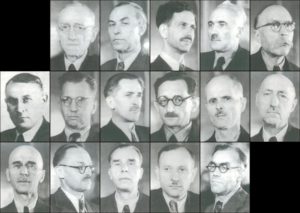 Marionetkowy „Rząd Tymczasowy” ustanowiony przez Stalina został uznany przez ZSRR, Czechosłowację i Jugosławię. Od 1 lutego 1945 organizował swoją administrację (powoływał wojewodów, starostów, wójtów) na terenach zajętych przez ZSRR po wyparciu hitlerowców. W dniach 4-11 lutego 1945 przywódcy koalicji antyhitlerowskiej: Winston Churchill, Franklin Delano Roosvelt oraz Józef Stalin spotkali się na konferencji w pałacu Potockich w Liwadii, w okolicach Jałty na Krymie. Podczas tego spotkania, zwanego konferencją jałtańską (konferencją krymską), zaakceptowano zabór polskich Kresów przez ZSRR, ponadto przyznano ZSRR „zwierzchnictwo” nad Polską oraz 1/3 terytorium Niemiec (Turyngia, Saksonia, Mekleburgia, Brandemburgia, Pomorze Przednie). W zamian za aneksję Kresów Polska miała otrzymać dotychczas niemieckie: Ziemię Lubuską, Pomorze Zachodnie, Prusy Wschodnie, Śląsk oraz Wolne Miasto Gdańsk.
Marionetkowy „Rząd Tymczasowy” ustanowiony przez Stalina został uznany przez ZSRR, Czechosłowację i Jugosławię. Od 1 lutego 1945 organizował swoją administrację (powoływał wojewodów, starostów, wójtów) na terenach zajętych przez ZSRR po wyparciu hitlerowców. W dniach 4-11 lutego 1945 przywódcy koalicji antyhitlerowskiej: Winston Churchill, Franklin Delano Roosvelt oraz Józef Stalin spotkali się na konferencji w pałacu Potockich w Liwadii, w okolicach Jałty na Krymie. Podczas tego spotkania, zwanego konferencją jałtańską (konferencją krymską), zaakceptowano zabór polskich Kresów przez ZSRR, ponadto przyznano ZSRR „zwierzchnictwo” nad Polską oraz 1/3 terytorium Niemiec (Turyngia, Saksonia, Mekleburgia, Brandemburgia, Pomorze Przednie). W zamian za aneksję Kresów Polska miała otrzymać dotychczas niemieckie: Ziemię Lubuską, Pomorze Zachodnie, Prusy Wschodnie, Śląsk oraz Wolne Miasto Gdańsk.
13 lutego 1945 premier emigracyjnego rządu w Londynie Tomasz Arciszewski odrzucił postanowienia z Jałty. 21 lutego 1945 parlament Polski Podziemnej – Rada Jedności Narodowej, na spotkaniu w Podkowie Leśnej uznała postanowienia z Jałty, podkreślając że powzięte w Jałcie postanowienia, bez udziału i zgody przedstawicieli Państwa Polskiego, narzucają Polsce ciężkie i krzywdzące warunki. Na konferencji w Jałcie przedstawiciele mocarstw wyrazili zgodę na utworzenie Tymczasowego Rządu Jedności Narodowej w Warszawie oraz zobowiązani go do przeprowadzenia wolnych, nieskrępowanych wyborów na zasadzie powszechnego głosowania.
W takiej, bardzo niekorzystnej sytuacji politycznej dowództwo AK przyjęło sowieckie „zaproszenie do rozmów”. Było ono w istocie grą operacyjną gen. Iwana Sierowa z NKWD (zbrodniarz stalinowski, współodpowiedzialny za mord w Katyniu). Pierwszą propozycję spotkania otrzymał Cichociemny, gen. Leopold Okulicki ps. Niedźwiadek, ostatni Komendant Główny AK, wówczas komendant NIE. Na posiedzeniu 21 lutego 1945 RJN jednomyślnie odradziła pójście na takie spotkanie. 4 marca 1945 odbyło się wstępne spotkanie w Pruszkowie delegacji AK z pełnomocnikiem Sierowa, płk Konstantinem Pimienowem. Według powojennych ustaleń, był oficerem sowieckiego kontrwywiadu wojskowego Smiersz naczelnikiem grupy operacyjnej NKWD w Radomiu. Ręczył „słowem honoru” za bezpieczeństwo Polaków.
Rozmowy z gen. Sierowem miały się odbyć 28 marca 1945 w willi w Pruszkowie przy ul. Pęcickiej 3 (obecnie ul. Armii Krajowej). 27 marca przybyli: delegat rządu i wicepremier na kraj Jan Stanisław Jankowski, ostatni Komendant Główny AK, Komendant Główny „NIE”, Cichociemny gen. Leopold Okulicki, przewodniczący Rady Jedności Narodowej Kazimierz Pużak (PPS „Wolność, Równość, Niepodległość”), tłumacz, wiceminister Departamentu Informacji Delegatury RP na Kraj Józef Stemler-Dąbski. Następnego dnia dotarli: Antoni Pajdak (PPS-WRN), Stanisław Jasiukowicz, Kazimierz Kobylański, Zbigniew Stypułkowski i Aleksander Zwierzyński (Stronnictwo Narodowe), Józef Chaciński i Franciszek Urbański (Stronnictwo Pracy), Adam Bień, Kazimierz Bagiński i Stanisław Mierzwa (Stronnictwo Ludowe) oraz Eugeniusz Czarnowski i Stanisław Michałowski (Zjednoczenie Demokratyczne). NKWD zdradziecko aresztowało wszystkich i następnego dnia wywiozło na Okęcie, skąd odlecieli specjalnym samolotem do Moskwy. Osadzono Ich w więzieniu NKWD na Łubiance.
W pokazowym procesie szesnastu (18-21 czerwca 1945), przeprowadzonym z pogwałceniem prawa międzynarodowego, 12 osób skazano, 3 uniewinniono. Antoni Pajdak został skazany w odrębnym procesie. Mocarstwa zachodnie zaakceptowały stalinowskie wyroki.
Cichociemny, gen. Leopold Okulicki otrzymał najwyższy wyrok – 10 lat więzienia. Do 24 grudnia 1946 więziony w celi nr 62 w więzieniu NKWD na Łubiance, tego dnia zamordowany.
Jako jeden z nielicznych negatywnie ocenił proces George Orwell:
Polacy zostali oskarżeni o to, że usiłowali zachować niepodległość własnego państwa, jednocześnie przeciwstawiając się narzuconemu ich krajowi marionetkowemu rządowi, jak również o to, że pozostali wierni rządowi w Londynie, który był w tym czasie uznawany przez cały świat, wyjąwszy ZSRR.
Gen. Leopold Okulicki ps. Niedżwiadek przed sowieckim sądem w Moskwie
Andrzej Chmielarz – Moskiewski proces przywódców Polskiego Państwa Podziemnego, biuletyn AK marzec 2017
Historię bohaterstwa Armii Krajowej kończą:
- zdrada aliantów oddających Polskę do rosyjskiej „strefy wpływów”,
- zaakceptowany przez świat niezgodny z prawem międzynarodowym „proces szesnastu” przywódców Polski Podziemnej,
- morderstwo w celi moskiewskiego więzienia na Łubiance ostatniego dowódcy AK Cichociemnego gen. Leopolda Okulickiego,
- nawet zdrada we własnych szeregach – żądnego władzy, prosowieckiego, chciwego megalomana bez zasad moralnych gen. Stanisława Tatara – który doprowadził do samobójczej „akcji Burza”, podjudzał do tragicznie zakończonego Powstania Warszawskiego oraz sparaliżował powojenną walkę o wolną Polskę m.in. organizując fałszywą „centralę konspiracyjną Hel”, defraudując państwowe pieniądze funduszu „Drawa” oraz przekazując władzom „Polski Ludowej” ok. 3 tys. teczek personalnych i dokumentów Oddziału VI (Specjalnego)…
Zobacz także – Zaopatrzenie Armii Krajowej
Źródła:
- informacje własne (archiwum portalu)
- Magdalena Hulas – Goście czy intruzi? Rząd polski na uchodźstwie wrzesień 1939 – lipiec 1943, Instytut Historii PAN, Warszawa 1996, ISBN 83-86301-20-1
- Iwan Rafał – Cichociemni – rekrutacja, szkolenie i przerzut do Polski, w: Koło Historii : materiały Koła Naukowego Historyków Studentów Uniwersytetu Marii Curie-Skłodowskiej, Tom 10 (2008) s. 77-106
- prof. Marek Ney-Krwawicz – Organizacja prac nad powstaniem powszechnym w kraju w Sztabie Naczelnego Wodza na obczyźnie Kwartalnik Historyczny 3-4/1995, ISSN 0023-5903 (pdf)
- Tadeusz Dubicki, Daria Nałecz, Tessy Stirling – Polsko – brytyjska współpraca wywiadowcza podczas II wojny światowej. t. I. Ustalenia Polsko – Brytyjskiej Komisji Historycznej, Naczelna Dyrekcja Archiwów Państwowych, Warszawa 2004, s.209, ISBN 83-89115-11-5
- Powstańcza burza i jej skutki (pdf)
- Grzegorz Mazur – Agonia Armii Krajowej 1944 – 1945 Instytut Literacki, Zeszyty Historyczne 114 (pdf)
- Grzegorz Rutkowski – Środki pieniężne przerzucone drogą lotniczą dla Polskiego Państwa Podziemnego, w: Dzieje Najnowsze 2018, nr 2, s. 5-20
- Waldemar Grabowski – Podziemny rząd – Delegatura Rządu RP na Kraj Niepodległość i Pamięć 22/2015 (pdf)
- Jan Karski – Tajna dyplomacja Churchilla i Roosevelta w sprawie Polski Instytut Literacki, Zeszyty Historyczne 78 (pdf)
- Andrzej Chmielarz – Moskiewski proces przywódców Polskiego Państwa Podziemnego, biuletyn AK marzec 2017 s. 1-12
- Valentine Ian – Baza 43. Cichociemni, wyd. Wołoszański, 2004, s.32, ISBN 83-89344-09-2
- Mieczysław Czerski – Produkcja banknotów przez Związek Walki Zbrojnej i Armię Krajową, w: Biuletyn Numizmatyczny nr 10-12 (258-260), październik – grudzień 1989, s. 3-9
Tł..

